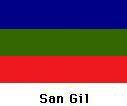 |
 |
XII. FIRST AGREEMENTS AND AUTHORITIES
The agreements about the construction of the stone trough for water and irrigation
ditch and about the baptism of the royal street. Taxes about the use of pita. Regulation
of home industries by weight and measurements by thread. Licit occupation of all
youngsters without work. The “Coso” Institution and the marking cyphers. The tariff
for peddlers. Who were the first authorities? The Royal Ensign and his ministers.
Galleries of burgomasters. From the silver dollar to large sum of money.
The carelessness of the Municipal Archives of San Gil is laughable. It is incomplete
and deteriorated because of the action of the armed conflicts and the moth. In it
exists letters and agreements of the municipal government., about which it is necessary
to mention briefly. The first agreement published on September 12, 1693 refers to
the rules of the bridge tolls of the rivers and brooks of the jurisdiction. It deals
with the receptacle of duties from the sisal use.The priests and their baggage were
excluded. This duty was worth a silver coin.Then, there is a curious agreement about
the protection of industry and commerce. It is dated January 22, 1694. It ruled on
the establishment of public stores, prohibiting the sale of articles manufactured
in habitable homes. “Threads’ weights and measure”, such public sales should have
been provided with marked, registered and sealed weights. Otherwise, violators were
obligated to pay a ne for six silver coins. Another agreement was the first step
toward the foundation of the Covered Market Company, which still functions today.
This one established public stores which function was to employ unemployed youth,
and the traditional Institute of Coso was ruled. The neighbors who had loose animals
were ned ten silver coins. A curious agreement elevated the tariff of the articles
from the public stores with the pretext that there was false silver circulating and
to defend the people from the swindlers and peddlers. Another disposition of the
Municipal Government was to order the production of cattle branding irons, to avoid
confusion on who was the owner of the grazing cattle. Another disposition was to
stamp all the official measures to avoid the outsiders speculation.
Later agreements (38) deal with the construction of the principal plaza, marking
the streets, naming the Royal Street and festivities with the occasion of the birth
of a prince of the Monarchs.The following interesting extract from Carlos D. Parra
(39), the agreement ordered by the Municipal Council, dated October 26, 1708, with
the occasion of the birth of the Prince Heir to the Monarch Don Felipe V, states:
“ The Attorney General of the town of Santa Cruz y San Gil of the New Baeza, upon
the knowledge that His Majesty Don Felipe V, who may God save as our King and Natural
Lord, expedited a Royal Edict participating his vassals of the new and happy succession
in the newborn Prince with festivities. Such Royal Edict includes this Royal town,
and to avoid omission, this loyal vassal commands to have these royal festivities
next Christmas. Given this decree on October 26, 1708, (signed) Juan de Rueda Rosales”.
A very curious act of the Municipal Council and Justice of the town gives funds to
the reparation of the stone through the major plaza, the adjudication of the contract
to Pedro Naranjo and the care and cleanliness of the water irrigation ditch: “ The
Municipal Council and Justice of the municipal government met at the town hall, to
free the water from dirt and viscosities and bad distribution of the irrigation ditch.
Such ditch is only three spans of the hand deep the enhancement of this construction
is entrusted in the person of Don Pedro Antonio Naranjo y Entralgo, who had the lowest
bidding. It is necessary that the ditch be kept clean and with running water. This
will be inspected by the Alderman Juan de Rueda Rosales. Given in Santa Cruz y San
Gil on February 3, 1668”. An even more curious act dated April 19, 1703, declared
our Lady the Virgin Maria Auxiliadora, whose image is venerated in the Church of
this town as Patroness against the ant plague. It reads: “In the town of Santa Cruz
y San Gil, on April 19, 1703, the gentlemen of the Municipal Council, Justice and
Government in accordance with the custom of good government agreed to the following:
It has been a long time that Our Lord has punished these lands with mountain or cemetery
ants, which have caused great pains in cornelds. We unanimously declare Our Lady
the Virgin Maria Auxiliadora the Patroness of this town against this plague, and
with the obligation of and acknowledgment of such patronage, the Municipal Council
gives notice to the Priest of this town, and in testimony of such agreement, we sign:
Gabriel Angel Ortiz, Manuel Estengo and Belarmino Gomez Romano, before me, Isidoro
de Jesus Rosales”. Possibly, due to the official declaration, above, the erection
of the statute of such Patroness was erected in the middle of the towers of the Cathedral
Church of San Gil on which pedestal the following inscription can be read:”You Are
The Glory of Our People”.